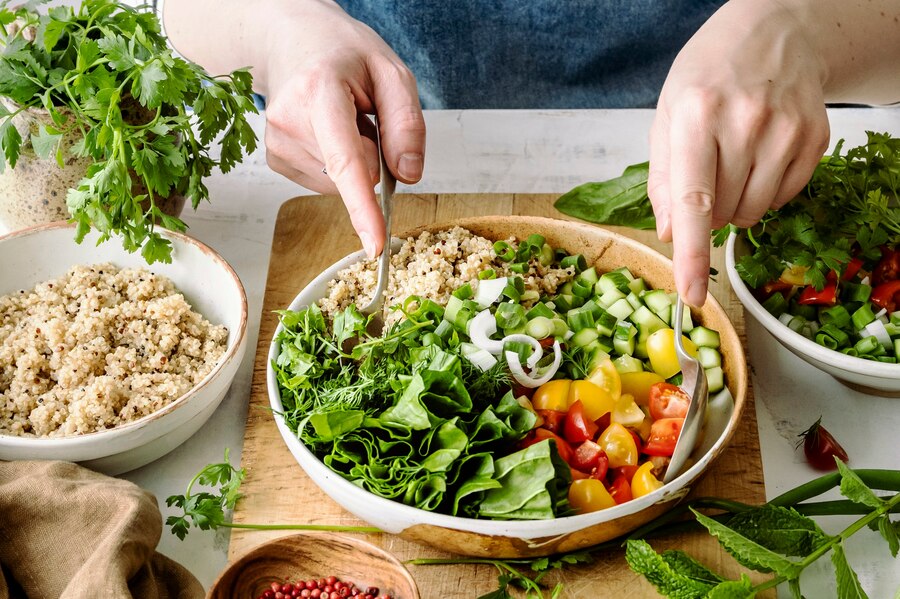In today’s fast-paced world, maintaining a healthy lifestyle can often feel like a challenge. For vegetarians, meal prepping provides a sustainable and efficient solution to ensure nutritious meals are readily available throughout the week. This article will explore easy vegetarian meal prep ideas, tips for efficient preparation, and how meal prepping can help save time and reduce food waste. We will also discuss the latest trends and advice to keep your meal prep both delicious and nutritious.
Why Easy Vegetarian Meal Prep is a Game-Changer
Vegetarian meal prep offers numerous benefits beyond just saving time. Whether you’re trying to maintain a balanced diet, manage weight, or simply eat more vegetables, meal prepping makes achieving these goals much easier. Here’s why easy vegetarian meal prep is essential:
- Time-Saving: With busy schedules, cooking every meal from scratch can be overwhelming. Meal prepping ensures you have ready-to-eat meals without spending hours in the kitchen every day.
- Healthier Choices: Meal prepping allows you to control ingredients, reducing the reliance on processed foods and offering a healthier, plant-based diet.
- Budget-Friendly: By preparing meals in bulk, you can save money by reducing food waste and purchasing ingredients in larger quantities.
- Consistency: It’s easier to stick to a vegetarian diet when meals are prepared in advance. You won’t be tempted to skip meals or reach for unhealthy alternatives.
- Variety: Meal prepping doesn’t mean eating the same thing every day. By planning your meals, you can mix up your protein sources, grains, and vegetables to keep your diet exciting and flavorful.
Tips for Easy Vegetarian Meal Prep
To make meal prepping for a vegetarian diet easy and stress-free, follow these key tips:
1. Plan Your Meals Ahead of Time
The first step in successful meal prep is planning. Start by choosing a week’s worth of meals and snacks that align with your dietary goals. Consider a mix of breakfast, lunch, dinner, and snacks. A well-rounded meal prep plan should include:
- Protein Sources: Tofu, tempeh, chickpeas, lentils, beans, edamame, and quinoa.
- Grains: Brown rice, quinoa, farro, couscous, and bulgur.
- Vegetables: Leafy greens, carrots, sweet potatoes, bell peppers, and cauliflower.
- Healthy Fats: Avocados, nuts, seeds, olive oil, and nut butter.
- Seasonings & Sauces: Spices, herbs, tahini, soy sauce, and vinaigrette.
2. Batch Cook and Store
Cooking in bulk can save a significant amount of time. Consider preparing large batches of grains, beans, and roasted vegetables that can be used in multiple dishes. For instance, quinoa can be made in bulk and stored for use in salads, wraps, and grain bowls throughout the week.
Invest in good-quality containers that are microwave- and freezer-safe. Glass containers with tight-fitting lids work best, as they preserve the freshness of your meals and reduce plastic waste.
3. Prep Ingredients, Not Entire Meals
If you don’t have time to prepare full meals ahead of time, simply chop vegetables, cook grains, and prepare proteins. This way, you’ll have ready-to-go components that can be quickly assembled into meals. For example:
- Chop Vegetables: Pre-chop vegetables for stir-fries, salads, and casseroles.
- Cook Grains and Legumes: Cook rice, quinoa, lentils, or chickpeas, and store them in separate containers.
- Marinate Proteins: Tofu, tempeh, and seitan can be marinated and stored in the fridge for quick cooking.
4. Keep It Simple and Versatile
One of the best strategies for easy vegetarian meal prep is focusing on simple, versatile ingredients that can be used in different dishes. For example, roasted sweet potatoes can be used in bowls, salads, or tacos. A batch of quinoa can serve as a base for a Buddha bowl or a stuffing for wraps.
5. Add Flavor with Sauces and Dressings
Meal prepping doesn’t have to mean bland meals. Enhance the flavor of your dishes with homemade sauces and dressings. A few options to consider include:
- Tahini Lemon Dressing: A creamy and tangy addition to salads or grain bowls.
- Peanut Sauce: Pairs well with stir-fries, noodles, or rice bowls.
- Vegan Pesto: Great for pasta or roasted vegetables.
6. Make Use of Freezer-Friendly Meals
Freezer meals are a lifesaver when it comes to meal prepping. Many vegetarian dishes can be made in large batches and stored in the freezer for later use. Some great freezer-friendly vegetarian meals include:
- Vegetable and Lentil Soup: A comforting dish that freezes well.
- Chili: Made with beans, tomatoes, and hearty vegetables.
- Vegetarian Burritos: Stuffed with rice, beans, vegetables, and cheese.
- Curry: Flavorful and filling, perfect for batch cooking.
7. Label and Organize
When storing prepped meals in the fridge or freezer, label each container with the meal name and date. This will help you easily identify which meals need to be eaten first and ensure you don’t forget about any items.
Easy Vegetarian Meal Prep Recipe Ideas
Now that you have the foundational knowledge of meal prep, here are some easy vegetarian meal prep ideas to get you started.
1. Chickpea Salad Bowl
A quick and nutritious lunch or dinner option, the chickpea salad bowl combines chickpeas, cucumber, cherry tomatoes, avocado, and greens. Top it with a tangy tahini dressing for extra flavor.
Ingredients:
- 1 can chickpeas, drained and rinsed
- 1 cucumber, diced
- 1 cup cherry tomatoes, halved
- 1 avocado, sliced
- 1 cup mixed greens
- 2 tbsp tahini
- 1 tbsp lemon juice
- Salt and pepper to taste
Instructions:
- Combine all ingredients in a bowl.
- Drizzle with tahini dressing and toss gently.
2. Vegetarian Stir-Fry
Stir-fries are quick to make and can be packed with nutritious vegetables and plant-based protein.
Ingredients:
- 1 block tofu, pressed and cubed
- 1 bell pepper, sliced
- 1 cup broccoli florets
- 1 carrot, sliced
- 2 tbsp soy sauce
- 1 tbsp sesame oil
- 1 tbsp grated ginger
- 1 cup cooked rice or quinoa
Instructions:
- In a pan, heat sesame oil over medium heat. Add tofu and cook until golden brown.
- Add vegetables, soy sauce, and ginger. Stir-fry for 5-7 minutes.
- Serve over rice or quinoa.
3. Roasted Vegetable and Quinoa Bowl
This bowl is packed with roasted veggies, quinoa, and a flavorful lemon-tahini dressing.
Ingredients:
- 1 cup quinoa, cooked
- 1 zucchini, chopped
- 1 red onion, chopped
- 1 sweet potato, cubed
- 1 tbsp olive oil
- 2 tbsp tahini
- 1 tbsp lemon juice
- Salt and pepper to taste
Instructions:
- Preheat the oven to 400°F (200°C).
- Toss the veggies with olive oil, salt, and pepper, and roast for 25 minutes.
- Assemble the bowl with quinoa and roasted veggies. Drizzle with tahini dressing.
Comparison Chart: Vegetarian Meal Prep vs. Traditional Cooking
| Aspect | Easy Vegetarian Meal Prep | Traditional Cooking |
|---|---|---|
| Time Spent | Prep all meals for the week in one or two sessions. | Cooking meals daily, which can be time-consuming. |
| Convenience | Meals are ready to eat when needed. | Requires cooking and cleaning daily. |
| Cost | Lower cost due to bulk ingredient purchasing. | Potentially higher costs with smaller portions. |
| Food Waste | Less food waste due to meal portioning and planning. | More food waste due to inconsistent meal sizes. |
| Variety | Variety in meals through component mixing. | Limited variety if meals aren’t planned. |
| Health Control | Full control over ingredients and portion sizes. | May involve more processed or unhealthy ingredients. |
Conclusion
Easy vegetarian meal prep is a powerful tool that can help you save time, reduce stress, and maintain a healthy lifestyle. By planning your meals, using versatile ingredients, and making use of freezer-friendly options, you can enjoy a week full of nutritious and delicious plant-based meals. Whether you’re new to meal prepping or a seasoned pro, these tips and recipes will help you streamline your vegetarian cooking routine and keep you energized throughout the week. With the right approach, meal prepping can be simple, enjoyable, and tailored to your taste preferences.










